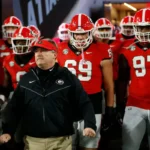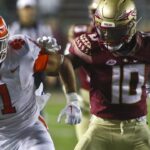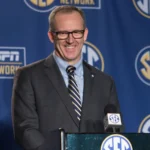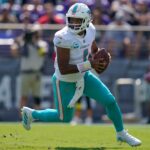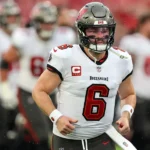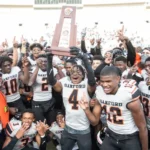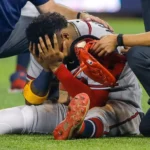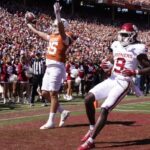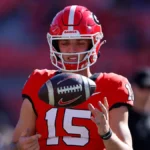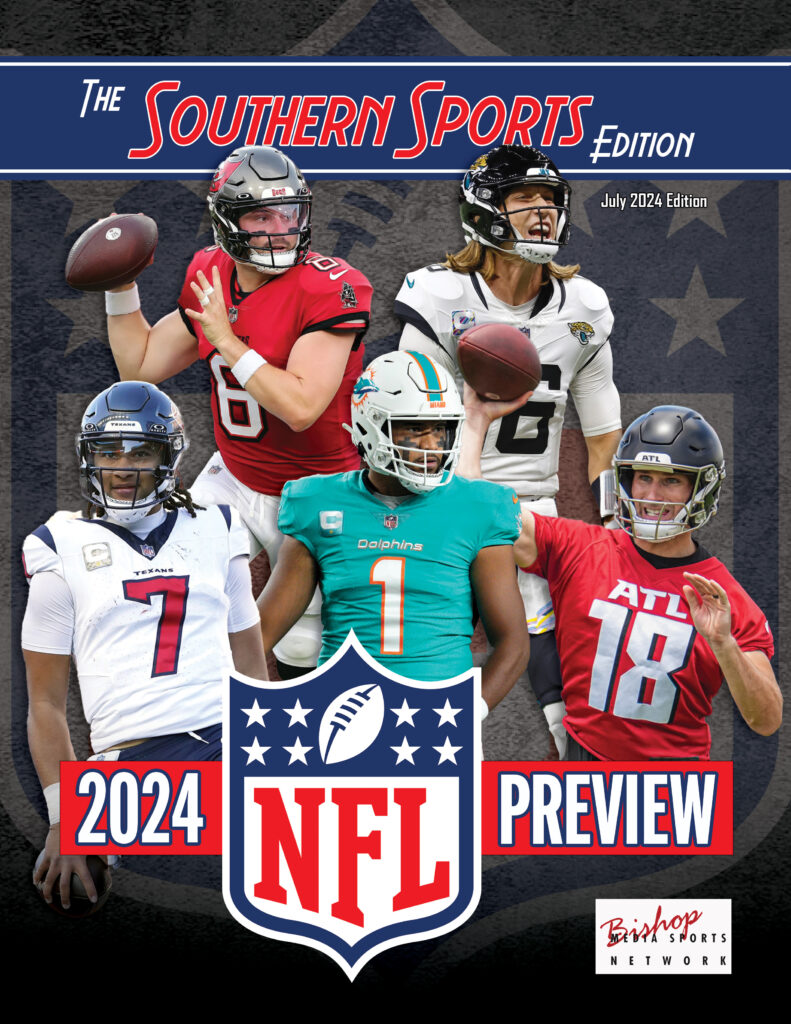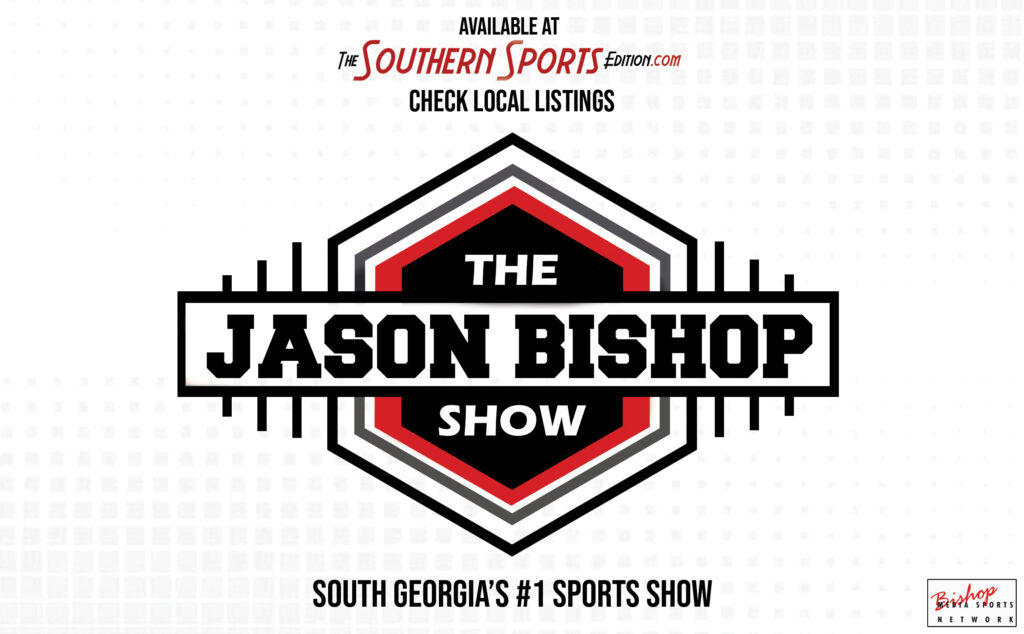Robert Craft
Red Means Stop
 By: Robert Craft
By: Robert Craft
TheSouthernSportsEdition.com news services
Georgia players are facing suspensions for driving violations, coach Kirby Smart confirmed on Tuesday. There has been another internal punishment: fines via the program’s collective, which have been happening for a while, Smart said.
“Our Classic City Collective for over a year has been substantially fining guys for those things,” Smart said. “That’s not something that’s new. That’s something that’s been ongoing outside of my jurisdiction that they decided to implement and have done for a considerable amount.”
Georgia has continued to have problems with driving-related arrests. Seven players have been arrested on driving-related charges since the January 2023 car crash that killed player Devin Willock and staff member Chandler LeCroy in which police found LeCroy had been drinking and racing with then-teammate Jalen Carter.
Safety David Daniel Sisavanh, arrested on reckless driving in February, has been dismissed from the program for what Smart only would term a ‘violation of team rules’.
There have been speeding tickets and arrests for speeding. Another player, Jamon Dumas Johnson, was arrested last year for a street racing incident that happened before Wilcock’s fatal crash.
Smart has declined to specify what the suspensions will be, only confirming them after the fact, such as last year when receiver Marcus Rosemy-Jacksaint was suspended for a speeding arrest.
As this season approaches, running back Trevor Etienne (DUI) and linebacker Smael Mondo (reckless driving, racing) seem likely to face suspensions. But Smart said he would not publicize those suspensions in advance.
“I don’t necessarily think it’s right to go down to the town square and publicly shame kids when that happens,” Smart said. “They go through a lot, and there’s a lot of remorse from these young men who’ve made mistakes. But our job is to educate, continue to grow these young men.”
Still, given all the arrests, following a tragic car crash, how has an otherwise disciplined program failed to curtail this serious issue?
“It’s a great question,” Smart said. “I’d love every solution possible because we actually write down now every time we talk about it and every time we address it, and we have someone in every meeting that hears that, and before I came, it was like 162 times it’s been mentioned. But if people go say, ‘Well, it falls on deaf ears, you got to have discipline, you’ve got to discipline someone.’ Well, we have, and we will continue to do so. If the actions require that, we’ll do what’s necessary to do that. But I do think the effective way in curtailing some things is when you go to their wallet and you find them because these fines have been substantial, and it’ll make you think twice about the mistakes you make.”
Georgia has used what Smart called proactive education, such as defensive driving courses. But Smart also defended the discipline process.
“As far as I know, there’s not one team in the country that’s ever suspended a player for a traffic violation similar to what Marcus Rosemy got suspended for,” Smart said.
“I don’t know if anybody’s ever kicked somebody off the team for that. And we have that. And we’re going to continue to be proactive. Repeated poor behaviors and poor decisions. In some cases, we have repeated behaviors, and in some cases, we have guys that make mistakes, and we’re going to punish them.”
Obviously with the tragedy that happened two years ago, that’s the biggest thing, guys realizing to be intentional in the moment. … It doesn’t matter if you get there five minutes early, it’s not going to change anything. Slow down and follow the rules of the road.
Big 12 Going Big Time?
 By: Robert Craft
By: Robert Craft
TheSouthernSportsEdition.com news services
Before FSU and Clemson can make a single business decision, they have to resolve their lawsuits with the ACC. That could take months if they settle, and years if they have their day in court.
“What’s going to happen?” That’s the $130 million dollar question these days in the Atlantic Coast Conference.
An important date is looming for the entire ACC: February 2025. The day ESPN has a “look-in” and will decide whether they continue the ACC’s contract until 2036.
If relationships were stable (and I mean completely), it would be a no-brainer for Disney to keep things as is. ESPN enjoys the locked-in price, especially with the revenue it makes from the ACC Network.
Considering their current relationship, if the network opts out … chaos in the streets. Today’s dynamic between media companies and NCAA could change in an instant if the ACC implodes.
SEC commissioner Greg Sankey stated at Media Day this week, “Our focus is on our 16 members.”
Big Ten’s Tony Petitti will likely side with Sankey next week, but for different reasons. Big Ten’s focus is not on realignment. There’s no realistic alternative at their level. The Big Ten Conference will likely do whatever Fox tells it to do, and this may well covet a powerhouse program that gets it into a hugely populous state.
That seems a more viable option than the SEC, which already has schools in Florida and South Carolina and whose partner, ESPN, has no incentive to pay more money to show Florida State and Clemson than it does now.
So where do they go? The Big 12 presents an interesting, less plausible alternative. On the one hand, The Big 12 Conference makes no more revenue than the ACC does now, so, what’s the point, right?
If Brett Yormark gets his wish and his presidents sign off on a private equity deal. Florida State and Clemson could get paid a lot more than they make now, and that’s before negotiating a new TV deal.
If the Big 12 follows through, all schools could possibly make Big Ten/SEC money without having to play a Big Ten/SEC schedule.
Why haven’t they done it already? Moving to the Big 12 is challenging. For Florida State and Clemson to be interested in making that move, they likely would demand to be paid closer to what the schools in the biggest two conferences are making each year.
They also would likely ask for financial help to pay their exit fees, penalties, and whatever else they could think of. FSU and Clemson are expensive programs.
While landing the Seminoles and Tigers would definitely be a game-changer for the Big 12 as a conference. At the university-level, teams and offices might balk at receiving significantly lower distributions each year, and we’re back to the unrest we’re at today.
Personally, I find it hard to imagine those schools wanting to join a less-glamorous conference. Perhaps an invite serves as leverage to gain better terms from the ACC.
Dollar Delivery
 By: Robert Craft
By: Robert Craft
TheSouthernSportsEdition.com news services
In Mandalay Bay (Las Vegas) last week, the impending House settlement dominated conversations at the National Association of Collegiate Directors of Athletics convention.
Panels were filled with questions, and not many answers. The top leaders in college sports don’t know the exact date when revenue sharing and the new world order will begin – speculation is the 2025-26 academic year.
Meanwhile, others are trying to figure out how much revenue they can share while keeping an athletic department up and running.
Alongside this, another major question remains: How will revenue actually be split up?
The NCAA and Power 5 conferences voted to sign off on the settlement agreement in May, agreeing to pay $2.77 billion in back damages to athletes over 10 years. The second piece of the agreement is revenue sharing, allowing institutions to pay $20-22 million annually to athletes.
How plaintiff attorneys divide back damages is expected to be how schools approach Title IX. This might shape a framework for revenue sharing. The settlement is on track to disperse 75% of TV revenue in back damages to football. From there, 15% would be funneled to men’s basketball, 5% to women’s basketball and the final 5% divided by the remaining athletes.
As administrators try to figure out how to split up revenue-sharing dollars, if Judge Claudia Wilken ratifies this portion of back damages it’s expected to be looked at as a “framework for the future”, antitrust attorney Jay M. Ezelle believes. The Birmingham, Alabama, based litigator with Starnes Law has advised NIL collectives and institutions in the NIL Era. Additionally, Ezell previously worked on NCAA investigations.
If Wilken ratifies a settlement that follows a similar breakdown of TV revenue, Ezelle believes it could help institutions navigate Title IX
.“Title IX pervades everything you do and an athletic department has to be in compliance with Title IX,” he said. “So, it is thoughtful and the right thing to do to be considerate. This is an issue that has not been litigated. And so, that presents uncertainty.
You have to address that uncertainty. That being said, the people who just say, ‘Let’s just distribute this 50-50 in order to comply with Title IX’ are not looking at the flip side of that. Because if you do it that way, you may actually be in violation of antitrust laws. Because you’re doing something that’s against the market.
The top-funded NIL collectives are spending between $13 to $20 million annually on football rosters at the moment. In basketball, the highest spending programs are pushing $5 million.
Ezelle believes splitting revenue evenly will only necessitate the need for collectives to step up. And it would also open up the possibility for football players to rationalize how much money they’re receiving vs. the revenue they’re producing.
For reference, The Big Ten announced a seven-year, $8 billion media deal with CBS, NBC and Fox in 2022. The SEC starts its new deal with ESPN this season, expected to be worth around $811 million annually.
The industry-wide financial stress test created by the House settlement is forcing campus leaders to look in the mirror and see the same image many have identified for years: bloated athletic departments.
Expenses must be adjusted in a new financial model, of course, and the safe bet is fat will be trimmed behind the desks and not the sidelines – and college sports will continue to flourish.
Swimming Upstream
 By: Robert Craft
By: Robert Craft
TheSouthernSportsEdition.com news services
The Dolphins took some salary-cap- hits on the defense this offseason, but let’s be serious: you don’t pick the Dolphins to win games because of their defense.
Their offense finished top five in total points, yards and completion percentage last season. We are still witnessing the prime of WR Tyreek Hill’s career, and Tua Tagovailoa should only improve at QB1.
Miami will hope that it can take the next step as a championship team under head coach Mike McDaniel. What does their case look like?
Oddsmakers are cautiously optimistic about the talented roster of the Dolphins, counting on the team to flirt with double-digit wins despite an incredibly competitive schedule in the AFC East.
Despite four consecutive winning seasons and back-to-back trips to the postseason, the Dolphins still haven’t won a playoff game since Bill Clinton was President.
Week 1 vs. Jaguars: Win
Week 2 vs. Bills (TNF): Win
Week 3 at Seahawks: Win
Week 4 vs. Titans (MNF): Win
Week 5 at Patriots: Win
Week 7 at Colts: Loss
Week 8 vs. Cardinals: Win
Week 9 at Bills: Loss
Week 10 at Rams (MNF): Win
Week 11 vs. Raiders: Win
Week 12 vs. Patriots: Win
Week 13 at Packers (Thanksgiving Night): Loss
Week 14 vs. Jets: Win
Week 15 at Texans: Loss
Week 16 vs 49ers: Loss
Week 17 at Browns (SNF): Win
Week 18 at Jets: Win
Final record prediction: 12-5
The AFC East will be difficult as usual with the Jets expected to be far better with a healthy Aaron Rodgers. It looks like the Bills might take a step back this year after several cap casualties this offseason.
The Dolphins have proven it can play with some of the best for most of the regular season, can it stay healthy and take the next step?
If the Dolphins get off to another hot start, they’ll be in a good position to handle another hellsome gauntlet at the end of the season with three playoff teams in the last four weeks.
The third time might be the charm for McDaniel and the Dolphins, they’ll pull out wins late in the season and claim the division title.
Buc-ing Their Own Trend
 By: Robert Craft
By: Robert Craft
TheSouthernSportsEdition.com news services
The Tampa Bay Buccaneers surprised many fans last year by winning a playoff game after most expected them to be bottom-feeders.
Can they keep out of the bottom this season?
For the Bucs, their nightmare situation involves Baker Mayfield regressing from a solid first year with the team.
Mayfield’s comeback season was the biggest reason why the Buccaneers made the playoffs. He ended the year with a career-high 4,044 passing yards, finishing third-place in Comeback Player of the Year votes.
Mayfield could regress from this past year. For any QB1 there’s no promise that they’ll get better, but at least now the 29-year-old double rookie has a whole season with the Bucs under his belt. There is great opportunity for further improvement. Mayfield may build, improve, and lead the team to yet another NFC South title.
While the Bucs do face some of the best teams in the NFL (Kansas City Chiefs, San Francisco 49ers, and Baltimore Ravens), they still have the 27th-easiest schedule based on 2023 game records.
Granted, much of this stems from playing in the NFC South, but there is still plenty of possibility for the Bucs to end the 2024 season with a winning record and even another NFC South title.
The Buccaneers might not have made the splashy headline moves like the Atlanta Falcons in the offseason, but this Tampa Bay team will once again be quite formidable on both sides of the football.
The Buccaneers could very well win the NFC South, making the playoffs for the 5th consecutive season.
However, there is a big difference between just making the playoffs and winning 2 or 3 postseason games to get to the big game.
Tampa Bay has a team capable of securing one of the 7 playoff spots in the NFC, likely be winning the division again. And it proved if there is a home playoff game in Tampa, it’s a tough place for an opponent to play.
Week 1: vs Commanders (W)
Week 2: at Detroit Lions (L)
Week 3: vs. Denver Broncos (W)
Week 4: vs. Philadelphia Eagles (W)
Week 5: at Atlanta Falcons (L)
Week 6: at New Orleans Saints (L)
Week 7: vs. Baltimore Ravens (L)
Week 8: vs. Atlanta Falcons (W)
Week 9: at Kansas City Chiefs (L)
Week 10: vs. San Franciso 49ers (L)
Week 12: at New York Giants (W)
Week 13: at Carolina Panthers (W)
Week 14: vs. Las Vegas Raiders (W)
Week 15: at Los Angeles Chargers (L)
Week 16: at Dallas Cowboys (L)
Week 17: vs. Carolina Panthers (W)
Week 18: vs. New Orleans Saints (W)
Nine wins would represent another year hot seat talk for Todd Bowles and the Bucs, who finished 8-9 and 9-8 in the previous two seasons respectively.
While the Falcons might end up as NFC South champions thanks to upgrades at quarterback and head coach, Tampa Bay will be in the hunt.
NIL Sunshine
 By: Robert Craft
By: Robert Craft
TheSouthernSportsEdition.com news services
NIL is coming to the Sunshine State for high school athletes.
The Florida High School Athletic Association Board of Directors passed sweeping bylaw changes earlier in the month to allow name, image and likeness activities for its student-athletes without forfeiting the ability to play high school sports.
The new policy passed unanimously after about 45 minutes of additional debate, including an argument from a coach in opposition of the new bylaw. The measure takes effect in time for the 2024-25 high school season.
With the change, 36 local athletic associations now allow student-athletes to participate in NIL deals on the high school level. The South Dakota High School Activities Association could become the 37th to permit NIL activities for high school players when the results of a membership vote become public in the coming days.
There’s been a significant shift over the past year in how high school administrators view NIL and it’s now acceptable in a majority of states from coast-to-coast. Florida is now officially part of the change.
The Sunshine State is a perennial producer of top high school athletes across multiple sports markets. Florida’s 2025 class has four five-star prospects in football alone – including the nation’s No. 1 linebacker in Solomon Thomas – and there are 56 players ranked four stars or higher. Florida’s 2025 class in basketball features two five-stars, including Five-Star Plus+ standout Cameron Boozer.
Plus, Florida is home to top high school athletes in women’s sports. The state is a haven for standouts in non-revenue sports, such as golf, soccer and lacrosse. The changes mean recruits in Florida and high school athletes in Florida can participate in NIL brand deals without fear of missing playing time.
In many ways, the new Florida High School Athletic Association NIL bylaw mirrors what is now acceptable for other high schoolers nationwide.
The new bylaws state that student-athletes and their parents/guardians must negotiate any NIL activities independent of their school, school district or the FHSAA.
Student-athletes will be prohibited from monetizing their NIL with the use of their school’s uniform, equipment, logo, name, proprietary patents, products and/or copyrights associated with an FHSAA member school and/or school district, either in public, print or social media platforms. Student-athletes are also encouraged to seek legal counsel and tax advice when considering NIL activities.
Interestingly, the FHSAA does include a line in its new bylaws that says a student-athlete could impact their amateur status by hiring a registered agent to manage his/her athletic career – other than for the purpose of advising on NIL-related matters.
The new rules aim to protect against recruiting. High-school-oriented collectives are focused on retaining talent locally at the high school level. This was of significant concern for high school coaches and athletic directors in Florida leading up to the change.
Florida is one of the most progressive states when it comes to NIL at the collegiate level. On July 1, 2001, college athletes in Florida became eligible to profit off their name, image and likeness under a bill signed into law by Gov. Ron DeSantis.
But up until recently, there has been some pushback from administrators and coaches about allowing it at the high school level.
Others have realized the threat of losing talent to other states (ones where NIL is allowed) as the biggest reason Florida is now allowing it.
Shaky Knees
 By: Robert Craft
By: Robert Craft
TheSouthernSportsEdition.com news services
Baseball is a metaphor for life, one of its most enduring lessons is that the universe gives not one whit for our collective desires; it will mete out blessings and hardships as it sees fit.
Last year, Ronald Acuña Jr. became the first player to hit 40+ home runs and steal 70+ bases in the same season, winning NL MVP for his efforts. It was a truly remarkable and historic season, one that fans of the Braves and the MLB will never forget.
In the first two months of the season, the Braves lost Spencer Strider, the 2023 MLB wins and strikeouts leader, with season-ending elbow surgery after two starts.
The Braves also lost Acuña, the first player to have as many as 40 homers and 70 stolen bases in a season, to an ACL tear. Acuña finished with 41 and 73 in 2023, while batting .337 with an NL-best 1.012 OPS.
Even with his early struggles this season, he still had a solid .351 OBP and was a threat every time he was at the plate and made opposing pitchers uneasy from the first pitch.
Leading off the first inning, he had a .333 average with an .857 OPS, and leading off any inning he hit .356 with a .420 OBP and .886 OPS. Not up to his lofty standards, but still the majors’ ninth-best average when leading off innings. A year ago, Acuña hit .384 with 18 homers and a 1.134 OPS leading off innings.
2023 was a triumphant return to form for Acuña after he tore his right ACL in July 2021. He returned to action in late April of 2022, but it took time to regain his mojo, posting a career-low 2.6 bWAR upon his return. (Not counting the shortened 2020 season.)
If that timeline is the career roadmap, then we may not see Acuña in peak form again until 2026. He will miss the remainder of this season.
Needless to say, Acuña’s absence is a huge blow to the Braves, who are currently chasing the Philadelphia Phillies in the NL East. Of course, it was a big blow when Atlanta lost him in 2021 — and they went and won the World Series.
Which likely brings us to-gulp- 2026 for the next potential glimpse of Acuña at an MVP level. He will be 28 that year, still in his baseball prime.
If he stays relatively healthy from that point forward, he can still fulfill his Hall of Fame potential. But who can predict how this all might play out, especially now that he has twice suffered these freakish knee injuries?
Acuña is still just 26 years old. He’s been through this injury and rehab before, and there’s little doubt that he’ll be back to electrifying the baseball diamond soon enough.
The results of that work were not fully apparent when he returned in late April 2022, and did not become truly evident until ’23.
Acuña undoubtedly will adopt the same mindset again, knowing what steps he must take, literally and figuratively, to return to MVP form.
That will not make his rehabilitation any less lonely or frustrating. The last thing Ronald Acuña Jr. wanted was to go through this again. Forgive him if he wants to scream.
Man, what a huge bummer.
In The Courts
 By: Robert Craft
By: Robert Craft
TheSouthernSportsEdition.com news services
Big 12 presidents and chancellors voted to approve proposals of what is expected to be a multi-billion dollar settlement in the House v. NCAA class-action lawsuit.
Their approval is another step toward a resolution in the landmark case likely to reshape the college sports business model.
The Big 12 is the first of the suit’s defendants to vote on the settlement terms. The remaining power conferences and NCAA Board of Governors also expected to vote this week.
Settlement details are expected to include north of $2.7 billion in back-pay damages the NCAA will owe to former Division I athletes, as well as a revenue-sharing model between power-conference schools and athletes for NIL deals in the future, according to sources briefed on the negotiations.
The damages, made available to Division I athletes dating back to 2016 as back-pay for lost name, image and likeness (NIL) earning opportunities, would likely be paid out over 10 years via a combination of NCAA reserve funds and reductions in future revenue distributions to conferences.
The revenue sharing would be an optional model for power-conference programs, potentially as soon as next year, in which 22 percent of those schools’ average annual revenue — or roughly $20 million a year — will be distributable directly to athletes.
If finalized, a process that will take several months, the settlement would be the next and most significant overhaul to the long-standing framework of amateurism in college sports.
Once the NCAA and power conferences agree on the terms and both sides in the case sign off, the settlement will be submitted to Judge Claudia Wilken of the U.S. District Court for the Northern District of California for preliminary approval. If that gets granted, there would be a set period of roughly 90 days in which those in the retroactive damages class have an opportunity to opt out, and those in the future revenue-sharing class can object to the terms of the agreement.
That’s followed by a final approving hearing, at which point, if the judge approves, the settlement officially goes into effect.
A settlement would give the NCAA more input on payment structures for the damages and revenue sharing, as well as safeguards against other impending legal battles.
Settling the House case would resolve Hubbard v. NCAA and Carter v. NCAA, two other high-profile antitrust suits in which the plaintiffs are represented by Berman and Kessler in the Northern District of California, and hinder any additional antitrust complaints over the next decade, according to sources briefed on the settlement negotiations.
This is considered an important aspect of the settlement terms for the NCAA, which has faced an onslaught of legal challenges in recent years.
Newly configured roster limits for power-conference sports are also expected as part of the settlement, with specific scholarship figures to be decided collectively by those leagues in the coming months.
The Big 12’s approval comes in the wake of internal dissension within the NCAA in recent days, as the smaller, non-FBS Division I conferences argue that the proposed funding plan for settlement damages puts a disproportionate financial responsibility on them.
Lingering questions also remain beyond the settlement over Title IX’s role in future revenue sharing, the future of third-party NIL collectives and the ongoing debate over unionizing efforts and employment status.
Even though this may be the start of the settlement, we are still far from the future that College Athletes deserve.
SEC QB1
 By: Robert Craft
By: Robert Craft
TheSouthernSportsEdition.com news services
Six quarterbacks were taken in the first round of the 2024 NFL Draft, tying the 1983 class, which included Hall of Famers John Elway, Jim Kelly and Dan Marino.
Despite the college landscape’s losses, SEC Football will have no shortage of talent at QB1 in the 2024 campaign.
From veteran transfers to young standouts, countless QBs are hungry for their shot at glory in the upcoming season. Here are my top 5 SEC quarterbacks heading into 2024-25.
- Garrett Nussmeier (LSU): Nussmeier’s only start last season came in LSU’s victory over Wisconsin in the ReliaQuest Bowl.
In the win, Nussmeier exploded with talent: 31 completions, 395 passing yards and 3 touchdowns. I feel confident Nussmeier can replicate this success next season in an expanded role.
LSU is going to score a lot of points, and, it’s [Nussmeier’s] team now. He knows that. Brian Kelly knows that. Everyone in that locker room knows that. And, I think we got a preview of it during the bowl game.
- Nico Iamaleava (Tennessee):Nico Iamaleava finished last season with 28 completions for 2 touchdowns and no interceptions.
During Tennessee’s 35-0 win over Iowa (Cheez-It Citrus Bowl), Iamaleava completed 12-of-his-19 pass attempts for 151 yards and a touchdown. He also had three scores on the ground. I believe Iamaleava might realize his full potential this season.
- Jalen Milroe (Alabama):Jalen Milroe finished this past season with 2,718 yards passing, 23 touchdowns and just 6 interceptions.
He was also a significant threat on the ground, collecting 468 rushing yards and a team-high 12 touchdowns on the ground.
While Nick Saban is no longer leading the Crimson Tide, My prediction is Milroe will continue to roll over his opponents.
Milroe and Kalen DeBoer, to me, are a lot like the french fry and milkshake combo. It sounds like two things that are very different wouldn’t go well together. I think that’s Kalen DeBoer and Jalen Milroe. You don’t think they’re supposed to go together and then you try it and you’re like, Oh, wow, this is phenomenal.
- Jaxson Dart (Ole Miss):Jaxson Dart led one of the most dangerous offenses in the nation last season.
In 2023, the 6-foot-2 QB recorded 233 completions for 3,364 passing yards and 23 touchdowns while only tossing 5 picks. I am forecasting these numbers will grow in the upcoming season.
1B. Quinn Ewers (Texas):Quinn Ewers threw for 3,161 yards and 21 touchdowns across 11 games as a redshirt sophomore last season, leading Texas to its first College Football Playoff appearance in program history.
Expect even more jaw-dropping statistics from Ewers this year.
Ewers, I think has the ability to have the best statistical performance out of anybody on this list this season. He has figured out what works in college football. The light bulb is on. It’s not blinking. It’s beaming.
1A. Carson Beck (Georgia):Carson Beck finished this past season ranked third nationally and first in the SEC in passing yards (3,941), as well as fourth in the nation in completion percentage (.724).
For his efforts, he was named a Coaches All-SEC Second Team selection. Obviously, I anticipate more accomplishments for Georgia’s QB1.
I have the highest level of confidence that [Beck] is going to execute his job at the highest level every single Saturday..
It’s All About The Money
 By: Robert Craft
By: Robert Craft
TheSouthernSportsEdition.com news services
I believe the official date for Clemson and FSU to inform the ACC of their intended departures for the 2025 season would be Aug. 15.
So, that would mean we would either have some form of resolution in court by then, which is not likely considering how it affects conferences across college football. The only other option, which is more likely, would be to settle out of court.
If it’s the latter, and FSU and Clemson part ways, ESPN will smartly decide in February not to pick up its ACC TV package through 2036.
That would send the ACC into Pac-12 territory, forcing it to sign a cheaper TV deal beyond 2027 (without its two megastars) or a straight-up league breakup in which some could end up fleeing to the Big 12 or even forming a new league.
My guess is there will be a group of ACC schools not getting into the SEC, Big Ten, or Big 12. The remaining teams will want to stick together in some form and take a cheaper TV deal to remain “mid-majors.”
We can sit here and debate which schools those are, or you can simply look at TV ratings and TV markets for the past few years and put two and two together.
Either way, not everyone is getting an invite to the Big 2 or a Super League. If FSU or Clemson has to spend a few years in purgatory (the Big 12) to get to the SEC or Big Ten, they’ll do it to get out of having to stick around in the ACC through 2036.
I just don’t think we’re going to see a 24-team Big Ten or a 24-team SEC down the road. Remember, the SEC’s TV deal runs with ESPN through 2033-34 and the Big Ten’s deal runs with CBS, NBC and Fox through 2029-30.
There’s no incentive for the schools in those leagues to add any more schools when they’ve got such a huge financial advantage in college football, unless they’re competing to sign top “free agent” schools such as FSU and Clemson or another school they value like North Carolina.
That essentially leaves the other ACC programs behind to come up with a solution to remain relevant and fund their athletic programs. The ACC will not completely fold.
Wait, I love this idea. I don’t know how likely it is, but I’m not sure anything in college football could surprise me anymore. Oregon State and Washington State need somewhere to land anyway, and if Clemson and Florida State bounce, the ACC should just lean into being totally unhinged. Give me Pac-12 after-dark vibes, every hour of every day.
